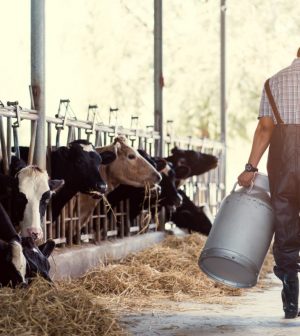- Navigating Your Midlife Crisis: Embracing New Possibilities
- City Raccoons Showing Signs of Domestication
- Mapping the Exposome: Science Broadens Focus to Environmental Disease Triggers
- One Week Less on Social Media Linked to Better Mental Health
- Your Brain Changes in Stages as You Age, Study Finds
- Some Suicide Victims Show No Typical Warning Signs, Study Finds
- ByHeart Formula Faces Lawsuits After Babies Sickened With Botulism
- Switch to Vegan Diet Could Cut Your Greenhouse Gas Emissions in Half
- Regular Bedtime Does Wonders for Blood Pressure
- Dining Alone Could Mean Worse Nutrition for Seniors
Bird Flu Virus Stays Active on Cow Milking Equipment for at Least One Hour

The spread of H5N1 avian flu to dairy cows has health experts and many Americans on edge, and now a new study finds the virus stays viable on milking equipment for at least an hour.
“Dairy cows have to be milked even if they are sick, and it has not been clear for how long the virus contained in residual milk from the milking process remains stable on the equipment,” said study lead author Valerie Le Sage. “It is concerning that the virus in unpasteurized milk can remain stable for hours and potentially infect farm workers or spread from animal to animal.”
Le Sage is a research assistant professor of microbiology and molecular genetics at the Center for Vaccine Research at the University of Pittsburgh.
She and her team believe the findings underscore the need for dairy workers to wear personal protective equipment (PPE) at work, to cut down on their odds for infection.
So far, there have been three known cases of human H5N1 infection linked to the current outbreak in dairy cows. All three cases occurred among dairy workers with long and close exposures to infected animals.
The illnesses were mild, but the fear among scientists is that H5N1 will mutate in a human to become easily transmitted between people, raising the specter of a new pandemic.
H5N1 originated in birds but has now spread to many species of mammals, including seals, dolphins and cows. The U.S. Centers for Disease Control and Prevention is watching the situation closely, but says that, for now at least, the risk to people remains low.
In the study, Le Sage’s team created a lab environment that mirrored the humidity and temperature of outdoor milking parlors in Texas.
They report that H5N1 virus particles “suspended in milk remained stable on metal and rubber for over one hour,” according to a university news release.
They also tested out particles of H1N1 “swine flu,” and found those particles remained viable for three hours on rubber and for at least one hour on stainless steel.
The findings were reported in the August issue of the CDC journal Emerging Infectious Diseases.
“Our data supports that milking equipment surfaces can stay contaminated for a long time, increasing the potential spread from a sick animal to a person,” Le Sage said. “These findings underscore the importance of face shields, masks and eye protection, and enhanced sanitization of equipment between cows, to reduce the risk to workers and to minimize the spread between the animals.”
More information
Find out more about bird flu at the CDC.
SOURCE: University of Pittsburgh, news release, June 27, 2024
Source: HealthDay
Copyright © 2025 HealthDay. All rights reserved.










